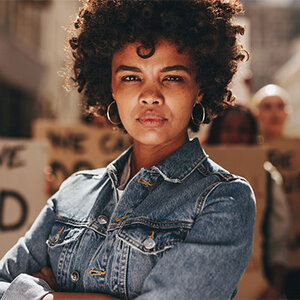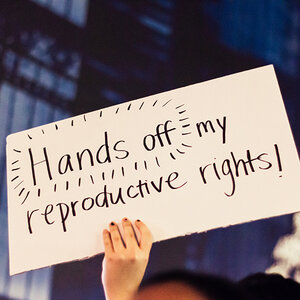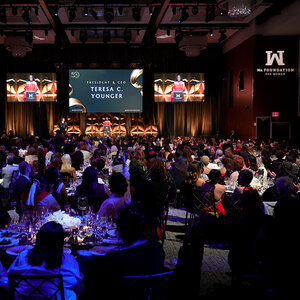Feminist philanthropy: Dismantling silos and raising long-term funding

The power imbalance in philanthropy—often maintained by those without intimate knowledge of a community’s historical context, the needs on the ground, and the most urgent issues—spurs activists in marginalized communities, especially Black women and girls, to call for more input in determining what should be prioritized, how it should be funded, and who gets the money.
Nonprofit leaders say funding for women and girls often falls short due to its overreliance on patriarchal power and a “white savior” mindset. Yet, Black women are at the forefront of many social justice causes and movements today, though even the scarce funding often comes with conditions not faced by their white counterparts.
“As a Black woman, I’ve seen how a white woman can ask funders for a certain amount for their organizations. But when someone like me asks, they give you a percentage of that, or they feel like you need to tap and dance differently to get those...[like] you’re not qualified to handle that much money,” said Latanya Mapp Frett, president and CEO of the Global Fund for Women and author of The Everyday Feminist: The Key to Sustainable Social Impact — Driving Movements We Need Now More than Ever. “There are all kinds of reasons for that. It’s maybe too easy to say racism is the problem. The challenge is that if you can look at the most marginalized communities worldwide, you’re usually going to find Black women, girls, and trans women. You have this incredibly vast under-resourcing going on, but then you have disproportionately Black women leading movements and the work happening to change our society. It’s a disconnect, and feminist philanthropy cannot tolerate that kind of disconnect if we want to get at the social issues we have in front of us.”
A report from the Women’s Philanthropy Institute (WPI) at the Lilly Family School of Philanthropy found that U.S. nonprofits working to advance women’s and girls’ causes received $7.9 billion in support in 2019, just 1.9 percent of overall charitable giving. Giving for women and girls of color amounted to even less—$356 million, or 0.5 percent of total foundation grantmaking in 2017, or about $5.48 per year for each woman or girl of color in the United States, according to the Ms. Foundation for Women report Pocket Change: How Women and Girls of Color Do More with Less.
“Pocket Change was our first stab at identifying that women and girls of color are doing more for less and that they are the key and center of almost every social justice and civil rights movement in this country and potentially worldwide,” said Ms. Foundation president and CEO Teresa C. Younger.
The report also showcased the increased need to hold philanthropy accountable to the affected communities and their movements, said Groundswell Fund CEO Yamani Yansá Hernandez. “[T]he Supreme Court rulings on affirmative action [in SFFA v. Harvard and SFFA v. UNC have] emboldened conservatives to target giving to people of color. We cannot back down in fear. It is a time for philanthropy to be bold, fight back, and take the risks that people on the ground cannot afford to.”
Indeed, the needs of women and girls are expansive and fundable, as the WPI report states: “Women are both more likely to give to women’s and girls’ causes, give larger amounts, and are more likely to report giving to domestic violence organizations, women’s centers, LGBT rights, cancer care and research, and economic opportunities for women and girls,” believing that “giving to women and girls provides the best social return.” The report also notes that barriers to women’s giving can include the “complexity and scalability of women’s issues, the connection to political issues, and the sex-segregated nature of women’s giving.”
What is feminist philanthropy?
At its core, feminist philanthropy aims to challenge the status quo and broaden the giving landscape in a way that includes everyone who, at one time or another, may have been excluded from mainstream philanthropy and, by doing so, tackles multiple aspects that arise from the needs of the community it serves.
“I would define feminist philanthropy as questioning and disrupting the white, cisgender-hetero-patriarchal status quo in traditional philanthropy,” said Hernandez. “Feminist philanthropy is the redistribution of wealth with trust in the leadership and strategy of those most marginalized, women and gender-expansive people of color.”
Feminist philanthropists support movements such as ending the pay gap, fighting for reproductive rights and bodily autonomy, securing a better economic outlook and better education and healthcare outcomes for women and girls, building crisis response and climate resilience, fighting for a free press, advancing democracy and civic engagement, and protect voting rights, amid calls for gender equity at the intersection of multiple issues. Feminist groups, organizations, and movements have been instrumental in creating awareness and issuing a call to action or to change funding strategies.
“We need to function with trust, and so, it really is different from traditional philanthropy because it is centering those closest to the issues,” said Younger. “It is trusting that they have the answers to move the process forward, and it’s also a recognition that it is more complex than just any one way of addressing a social issue.”
The Bridgespan Group and Shake the Table argue in Lighting the Way: A Report for Philanthropy on the Power and Promise of Feminist Movements that philanthropists should invest about $1.5 billion annually in women’s rights to support feminist movements worldwide.
Feminist philanthropy is the redistribution of wealth with trust in the leadership and strategy of those most marginalized, women and gender-expansive people of color.
—Yamani Yansá Hernandez, Groundswell Fund
The argument is that those on the ground should receive the money to make the best decisions for the community.
“[W]e want to look at feminist philanthropy from a different approach, one rooted in solidarity, trust, and building collective power, and what that means is that we must provide unrestricted general [operating support] grants,” said Mapp Frett. Funders must be “completely flexible and cover the cost of social justice work. You have to understand what they need...just being in listening mode all the time so that we can be there to help drive those movements when they need us.”
There is, however, a difference between funding for women and girls and feminist philanthropy, which is focused on movement building based on trust and solidarity. And building feminist movements often entails funding smaller organizations.
“Some of the biggest challenges organizations face is the idea of fully trusting women and women of color to do the work that needs to be done. Philanthropy is looking for a bright and shiny leader they can follow instead of understanding that solid leadership and answering communities they may need to learn about are doing the work,” said Younger. “So, some of the greatest challenges are the size of organizations that philanthropy needs funding. So, stop looking for the bright, shiny, and look for the consistent and present [and be] willing to take a ‘risk’ to support smaller nonprofits.”
The women leading the way represent many different cohorts across the spectrum, said Kiersten Marek, founder of Philanthropy Women and author of Feminist Giving: Creating New Frontiers in Social Change: There is a multimillionaire faction headed by groups like Women Moving Millions and Women Donors Network, state-based women’s foundations and policy/political activist groups, corporate women’s philanthropy, and those who support WPI and take a research-focused approach. “We need to have a big tent and let everyone in. We can’t afford to alienate anyone, especially folks who will work hard to share the vision and strategies of women givers.”
Some of the biggest challenges organizations face is the idea of fully trusting women and women of color to do the work that needs to be done. Philanthropy is looking for a bright and shiny leader they can follow instead of understanding that solid leadership and answering communities they may need to learn about are doing the work.
—Teresa C. Younger, Ms. Foundation
Activists working on the front lines believe feminist philanthropy cannot be put into a singular box; they call for the philanthropic response to be more nimble and less confining in its vision.
“We have to fund the organizations based on what they need now rather than by the sector they live in…[to] understand the... interrelatedness of the many social issues women are trying to address. [T]hey can’t say, ‘I am only working on climate.’ They also have to work on economic growth and education,” said Mapp Frett. “It’s these women who are doing this work that is instinctively more expansive...whether it’s abortion or...racial equity or...all those things, it affects the same people.”
For funders, feminist organizations and movements can appear risky, in part because they don’t always align with the rigid parameters they set for grantees, including an emphasis on impact measurement or other fixed metrics—for which smaller grassroots organizations lack the capacity.
“We have de-siloed the Ms. Foundation, which is exactly what needs to happen within broader philanthropy. Instead of asking people to apply around one area, understand that these are interconnected...recognize that policy changes and initiatives will take much longer than a five-year window,” said Younger. “Organizers need the capacity supports to grow their organizations, not just scale them up into something bigger; [u]nderstand that they need the support of operating day-to-day.”
How does race play a part?
Black Feminist Fund co-founder Hakima Abbas and Human Rights Funders Network deputy director Kellea Miller wrote in a 2021 blog post: “Black women’s leadership in social movements has faced what scholars call intersectional invisibility, in which ‘Black women are often overlooked in people’s conversations about racism and sexism even though they face a unique combination of both of these forms of discrimination simultaneously.’”
This disconnect has surfaced in a call for more support from major foundations, especially for the Black women who are disproportionately leading movements and struggle to acquire support and resources. In an open letter, 11 major foundations and philanthropic leaders called for an increase in funding to Black feminist organizations and movements, including leaders of the Solidaire Network; Melinda French Gates’s Pivotal Ventures; the Ford, Clara Lionel, Libra, Farbman Family, Satterberg, and John D. and Catherine T. MacArthur foundations; the Foundation for a Just Society; the Meadow Fund; and the Wellspring Philanthropic Fund. Each went on to fund the Black Feminist Fund and others working to end racial inequity, gender inequity, and other forms of systemic violence.
In 2018, the Ms. Foundation launched a strategic five-year plan to invest in women and girls of color, who head 97 percent of the foundation’s grantee partners, while making general operating grants and providing the wraparound support needed to impact the field for years to come. “We want to see more strategic communications, grant dollars, capacity-building support going to organizations run by women and girls of color, and general operating support in those areas,” said Younger.
“The Southern Black Girls and Women’s Consortium is one model that shows and demonstrates how we have been able to give out millions of dollars by coming together. There should be a broad-scale commitment on every level, not just in the private philanthropy sector but in the public sector, with an equal goal of equality and a substantial investment to build the capacity infrastructure and provide support to the existing ecosystem of the groups that are doing this work,” said founder LaTosha Brown, who also co-founded Black Voters Matter.
What are the challenges to funding?
Groundswell Fund’s Hernandez said that one of the biggest challenges in securing funding “is philanthropy itself and its roots in white supremacist capitalist patriarchy."
"Funding of feminist movements is like an ebb and flow, instead of a consistent stream of funding at the scale and level that’s needed," said Brown. "We need more foundations and more vehicles to fund feminist-centered work and expanded visibility to help people understand the needs and opportunities. I even had a funder not too long ago say to me, ‘Well, since Black women are really doing well, why should we continue to fund Black women?’ As if Black women were a trend. I think the greatest issue is around the scale, because we’re coming up against systems and institutions that have been rooted in white male patriarchy.”
In addition, many of the issues feminist groups are centering may be considered politically risky by funders but are the driving force behind what activists say should be funded. The Lighting the Way report implores funders to reexamine risk to recognize that the greatest risk is in not investing in feminist leaders and organizations that are tackling systemic injustice.
Hernandez argued that the “fight for bodily autonomy is interconnected. The Dobbs decision alone let us know that it is a vehicle for undoing many other rights. We can see the urgent need to support birth justice, trans and gender justice, healing justice, climate justice, and much more.”
Younger and Mapp Frett concurred that funders must understand the causal relationships among interconnected issues when deciding what to fund. Democracy, voting rights, and women’s rights are core recurring tentpole issues that most feminist groups and movements are working on.
“What we know about philanthropy and working within feminist movements is that they are multi-dimensional, so we need to look at all those issues as having multiple spaces and intersections for what that looks like,” said Younger. “What are the topics we need to fund in this area? All of them. All of the issues affecting the lives of women and their communities need to be funded in a perspective that allows us to take a long-term approach, whether that’s reproductive rights or...environmental justice or...democracy building and voting rights, or education. All need to be seen as a comprehensive way of addressing the multiple issues affecting our lives.”
Which funding models work best?
Simply put, leaders like Hernandez agree that funders should “trust funding those who are in the crosshairs of injustice, with multiyear, general operating grants, removing arduous reporting and application barriers.” Supporting grassroots organizing is also essential as an engine to drive social change, especially intersectional organizing.
“Fund the leadership of women and gender-expansive people to the scale needed to win—this means more than the legally required 5 percent spending for foundations with billions in reserves. Do not duplicate the work of grantees as philanthropic entities. Funders need to give money and then get out of the way,” said Hernandez.
Strategy and collaboration are other areas leaders say funders should explore. In 2021, the Generation Equality Forum convened by UN Women concluded with nearly $40 billion in commitments supporting efforts to advance gender equality over the subsequent five years. Investors included MacKenzie Scott, Melinda French Gates, Roshni Nadar Malhotra, the Thankyou Charitable Trust, and the Estée Lauder Companies Charitable, Bill & Melinda Gates, and Rockefeller foundations. In 2022, global collaborative Co-Impact launched the Gender Fund to disburse its $1 billion commitment in large, long-term, flexible funding to predominantly women-led, locally rooted organizations in Africa, Asia, and Latin America to advance gender equality and women’s leadership, with at least 10 percent of the funds raised awarded to feminist and women’s rights groups and movements.
“Being strategic—working in collaboration with other, often larger funders, to raise more funds for gender equality—is a big key to this movement sustaining itself and growing,” said Philanthropy Women’s Marek. “Being intersectional, willing to acknowledge and attempt to account for multiple forms of oppression when funding grantees, is also super important.”
Women’s Funding Network (WFN) president and CEO Elizabeth Barajas-Román explained that women’s funds are also built on a wide variety of gifts from middle-income and working-class donors touting the effectiveness of a “‘horizontal’ or shared model of fundraising and grantmaking where there is shared power among donors at all levels with community leaders and activists.”
“When donors invest in a women’s fund, they become part of a league of committed people working towards social change,” she said.
Funding across the ecosystem of women’s causes and providing long-term general operating support can make the difference, as Lighting the Way indicates and funders agree.
“$1 million is great, but $100,000 a year over 10 years is even better,” said Mapp Frett. “Then I know what’s coming. I can count on it. I can plan against it. And that kind of long-term support changes the runway for these organizations and what they can do. It changes the success and impact they’re able to have.”
What about “rage giving?”
In “Rage donations and mobilization: Understanding the effects of advocacy on collective giving responses,” published in the British Journal of Social Psychology, “rage giving” is defined as charitable giving that is “sometimes a form of collective action, and that collective responses can be influenced by advocacy.” The article considers “whether known drivers of collective action—anger, efficacy, and identification—also promote collective giving.”
Rage giving surged in the wake of the 2016 presidential election and the 2022 Supreme Court decision in Dobbs v. Jackson Women’s Health Organization, which overturned Roe v. Wade, but has dropped off as funders have either stopped or shifted their funding.
Some, like Marek, maintain that rage giving is an important aspect of feminist giving because it connects the personal and political and indicates that women can shift the political and social landscapes through concerted funding at pivotal moments. Others believe those efforts would be better directed toward intermediaries like the Ms. Foundation, with legacies of funding small grassroots organizations with grant dollars and supporting leadership and policy work.
Mapp Frett cautions that while rage giving can effectively help “grow” issues and advance feminist movements, foundations, and individual donors should also “value the slower path to lasting change and stick with it.”
Critics of the term “rage giving” would like to focus less on the “rage” part of the equation, which some might view as embedded in sexism.
“I think we get labeled whenever women respond to...a social issue, be it pain or oppression,” said Brown. “Now, is righteous rage necessary and needed? Absolutely. I’m not opposed to that. But sometimes, our giving is just strategic....There is an onslaught of policy issues that disproportionately impact women. That creates not just rage but also an opportunity for people to pay attention and respond.”
Where does feminist philanthropy go from here?
According to the WPI report In for Women & Girls: How Women's Fund and Foundation Donors Are Leading Through Philanthropy, funded by the Gates Foundation, donors to women’s funds and foundations are more likely to be giving at capacity to women’s and girls’ causes and would increase their giving if they had more resources. None of the 187 respondents said they would end their giving in the next five years, and just 2.1 percent said they were considering reducing their support.
Younger said that it’s important to look at gender expansively so that everyone is included in the conversation to make the world better for everybody, not just women and girls.
“When you’re looking at issues around gender equity...ask yourselves, ‘What are the dollars going for? How are we trusting it? Are we believing? And supporting the dollars as they move out the door? What is the impact?’” she said.
Barajas-Román emphasized that WFN’s work “is based on the premise that large-scale social change comes from collective impact and catalytic leadership” and engages in research, recognizes the interconnection of multiple issues, supports multifaceted approaches, fosters cross-sector collaborations, invests in culture change work, and invests in community partners and programs over multiple years.
“Once funders are sure they’re value-aligned with the grantees, it means not asking the grantees to waste time on countless reports to prove themselves again and again, so they can actually spend their time doing the work without having to justify their every expense to a paternalistic overseer,” said Barajas-Román. “We need to trust our partner organizations to decide what is best for their communities and then to make multiyear investments so they can do long-term planning.”
Hernandez noted how grassroots power is built and maintained through organizations with strong infrastructure and the agility to deliver material changes in people's lives while maintaining an organized base and the ability to defend key victories and win year after year. Groundswell Fund’s programs support reproductive, gender, and social justice organizations, and its Grassroots Organizing Institute and Integrated Voter Engagement provide capacity-building support.
“This moment in history is remarkable in the sheer number of people coming into social change work. Our grantee partners have a chance to bring millions of new people into their ranks to power a much-needed sea change in policies, systems, and culture,” said Hernandez.
Ultimately, the women and girls at the center of feminist movements truly matter to the organizations funding them, and there has to be a dedication to and an affinity for improving the lives of marginalized communities.
“When you change the world for a girl, you change the world. If we support and lift up the most marginalized in our communities, we create a better community for all of us,” said Brown. “Even the way we do the work, it’s not just the outcome; the process also matters. We’ve been very intentional...to do the work from a lens of joy. It’s the wisdom of community, the celebration of community, the celebration of life and joy.”
Younger, while referring to philanthropy as a “fickle friend” who might not support causes sustainably or consistently, emphasized that feminist funders like the Ms. Foundation must stick with the work. “We have looked at what is the intersection of race and gender and how we want to lift that most expansively and inclusively, and that is part of our vision for the future, which is to promote a safe and just world where power and possibility are not limited by race, gender, class, sexual orientation, gender identity, age, or disability,” she said. “We’re not doing it perfectly, but we are attempting to hold all of those pieces in the work we are striving to do, because we believe that equity and inclusion are the cornerstones of a true democracy in which the worth and dignity of every person are valued.”
Lauren Brathwaite is content editor at Philanthropy News Digest.
(Photo credit: GettyImages/jacoblund)







